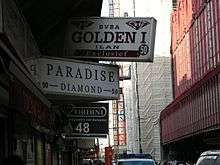Antwerp diamond district
Antwerp's diamond district, also known as the Diamond Quarter (Diamantkwartier), and dubbed the Square Mile,[1] is an area within the city of Antwerp, Belgium. It consists of several square blocks covering an area of about one square mile. While as of 2012, much of the gem cutting and polishing work historically done in the neighborhood had moved to low wage centers elsewhere, about 84% of the world's rough diamonds passed through the district, making it the largest diamond district in the world with a turnover of 54 billion dollars.[2] Each year, approximately 50% of the rough diamonds return to Antwerp for cutting and polishing. [3]

Over $16 billion in polished diamonds pass through the district's exchanges each year. There are 380 workshops that serve 1,500 companies. There are also 3,500 brokers, merchants and diamond cutters. In 2017, roughly 234 million carats were traded in the district, an area with a workforce of 30,000 people. Over 80% of rough diamonds were purchased in Antwerp.[4]
Within the area is the Antwerp World Diamond Centre, and four trading exchanges[5] including the Diamond Club of Antwerp and the Beurs voor Diamanthandel, both of which were founded by Hasidic diamantaires,[6] the Antwerpsche Diamantkring and the Vrije Diamanthandel.[7]
The neighborhood is dominated by Jewish, Jain Indians, Maronite Christian Lebanese and Armenian dealers, known as diamantaires.[8][9] More than 80% of Antwerp's Jewish population works in the diamond trade; Yiddish was, historically, a main language of the diamond exchange.[10] No business is conducted on Saturdays.[11]
Location
The diamond district is located adjacent to the Central Station (Antwerp Centraal) and a few minutes' walk to Meir, Antwerp's main shopping street. The Antwerp Zoo is also nearby. There are numerous and various restaurants, bars and cafes around the district.[12] Restaurants include: Ho Chan House (Chinese), San Remo and Da Vinci Pizzerias. Bars include: Bier Central (boasts over 200 types of beers), Kelly's Irish Pub. Cafes include: Del Rey.
History
Antwerp has been a focus of the diamond trade since 15th century.[13] The industry was transformed when Lodewyk van Berken invented a new form of diamond polishing tool, the scaif, which enabled the creation of the stereotypical sparkling, multifaceted diamond. This attracted orders from European nobility - and attracted other craftsmen to Antwerp.[14] Charles the Bold commissioned him to cut and polish the Florentine Diamond. In the 1890s a diamond industry was established in Antwerp by families of diamonds traders and manufacturers who came from Amsterdam, Netherlands.[15]
After the Second World War, the city's mayor encouraged Jews to return to Antwerp and many did so, including some who were working in the diamond trade. That helped to boost the industry. There was a subsequent decline however, starting in the 1960s, when some of the polishing business moved to India because of lower labour costs. Subsequently, some of the cutting business also moved to that country.[16] [17] A 2019 research study stated that India continued to dominate the cutting and polishing industry.[18]
See also
- Antwerp Diamond Bank
- Antwerp Diamond Heist
- Diamond District - New York City
- Diamond Exchange District - Israel
- Jewelers' Row, Philadelphia
- Kimberley Process Certification Scheme
References
- Organized Crime: Culture, Markets and Policies By J. M. Nelen, p90
- John Tagliabue (November 5, 2012). "An Industry Struggles to Keep Its Luster". The New York Times. Retrieved November 6, 2012.
- "The diamond people: How Antwerp became a world leader". Flanders Today. 25 June 2020. Retrieved 25 June 2020.
Antwerp is the capital when it comes to diamonds. There are a lot of cities that would like to call themselves the diamond capital, but there is only one.
- Garcia-Carballido, Carmen (5 July 2018). "An Afternoon in Antwerp's Historic Diamond District". The Gemmological Association of Great Britain.
- Minerals Yearbook 2008: Area Reports, International, Europe and Central Eurasia, Volume 3, By Interior Department (COR)
- "The Diamond Trade: Diamond Bourses of Antwerp". Allaboutgemstones.com. Archived from the original on August 23, 2011.CS1 maint: unfit url (link)
- The industry | Antwerp World Diamond Centre Archived 2015-06-26 at the Wayback Machine
- Antwerp Diamond District. Virtual Globetrotting (2007-03-31). Retrieved on 2011-06-02.
- Recession takes the sparkle out of Antwerp's diamond quarter | World news. The Guardian. Retrieved on 2011-06-02.
- Jewish Quarter and Diamond Quarter - Antwerp, Belgium. Sacred-destinations.com. Retrieved on 2011-06-02.
- Frank, Ben G. (1992). A travel guide to Jewish Europe. Pelican Publishing. p. 311. ISBN 9781455613298.
- "Visit Antwerp". Antwerp World Diamond Centre. Retrieved 2016-10-26.
- Rincón, David Alonso (May 21, 2016). "En el corazón del barrio de los diamantes de Amberes". Libre Mercado (in Spanish). Libertad Digital. Retrieved January 16, 2018.
- Edward Jay Epstein (1982). The Diamond Invention. Hutchinson. p. 272. ISBN 0091476909.
- "Diamonds in Geneva". DiamAlps.
- "The diamond people: How Antwerp became a world leader". Flanders Today. 25 June 2020. Retrieved 25 June 2020.
- "For thousands of diamond traders, a new bourse in Surat promises to add to the shine". Economic Times. 29 March 2019. Retrieved 25 June 2020.
Close to 90% of the worlds diamonds pass through Gujarat for polishing, Over 90% of the world's diamond pieces are cut in Surat
- "The Global Diamond Industry 2019" (PDF). Bain & Company. 21 March 2019. Retrieved 25 June 2020.